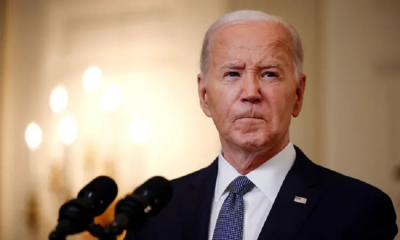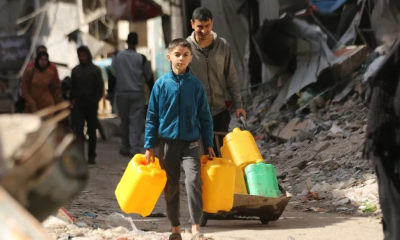Features
How Hamas built a force to attack Israel on 7 October
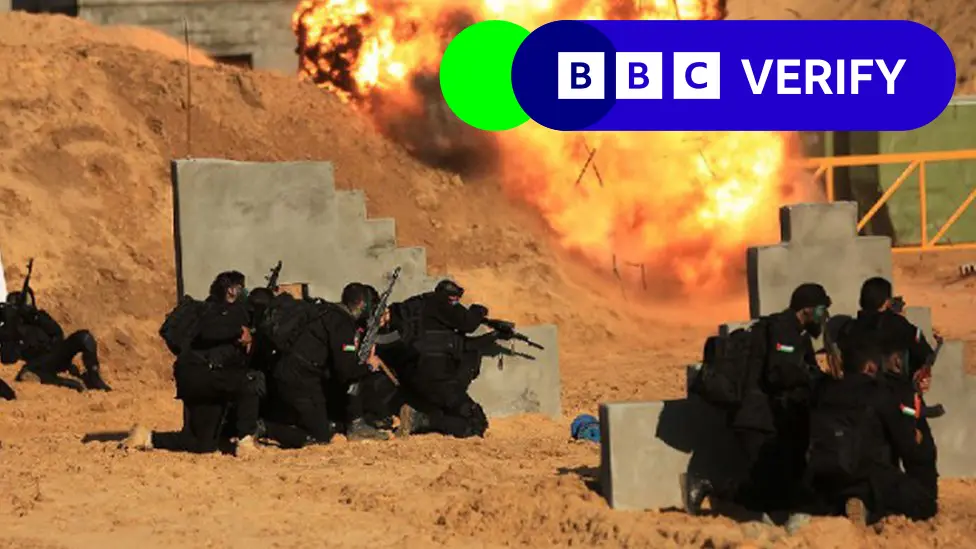
Five armed Palestinian groups joined Hamas in the deadly 7 October attack on Israel after training together in military-style exercises from 2020 onwards, BBC News analysis shows.
The groups carried out joint drills in Gaza which closely resembled the tactics used during the deadly assault – including at a site less than 1km (0.6 miles) from the barrier with Israel – and posted them on social media.
They practised hostage-taking, raiding compounds and breaching Israel’s defences during these exercises, the last of which was held just 25 days before the attack.
BBC Arabic and BBC Verify have collated evidence which shows how Hamas brought together Gaza’s factions to hone their combat methods – and ultimately execute a raid into Israel which has plunged the region into war.
‘A sign of unity’
On 29 December 2020, Hamas’s overall leader Ismail Haniyeh declared the first of four drills codenamed Strong Pillar a “strong message and a sign of unity” between Gaza’s various armed factions.
As the most powerful of Gaza’s armed groups, Hamas was the dominant force in a coalition which brought together 10 other Palestinian factions in a war games-style exercise overseen by a “joint operation room”.
Prior to 2018, Hamas had formally coordinated with Palestinian Islamic Jihad (PIJ), Gaza’s second largest armed faction and – like Hamas – a proscribed terrorist organisation in the UK and other countries.
Hamas had also fought alongside other groups in previous conflicts, but the 2020 drill was billed in propaganda as evidence a wider array of groups were being unified.
Hamas’s leader said the first drill reflected the “permanent readiness” of the armed factions.
The 2020 exercise was the first of four joint drills held over three years, each of which was documented in polished videos posted on public social media channels.
The BBC has visually identified 10 groups, including PIJ, by their distinctive headbands and emblems training alongside Hamas during the Strong Pillar drills in footage posted on the messaging app Telegram.
Following the 7 October attack, five of the groups went on to post videos claiming to show them taking part in the assault. Three others issued written statements on Telegram claiming to have participated.
The role of these groups has come into sharp focus as pressure builds on Hamas to find dozens of women and children believed to have been taken as captives from Israel into Gaza by other factions on 7 October. Three groups – PIJ, the Mujahideen Brigades and Al-Nasser Salah al-Deen Brigades – claim to have seized Israeli hostages on that day.
Efforts to extend the temporary truce in Gaza were said to be hinging on Hamas locating those hostages. The structure was set up in 2018 to coordinate Gaza’s armed factions under a central command.
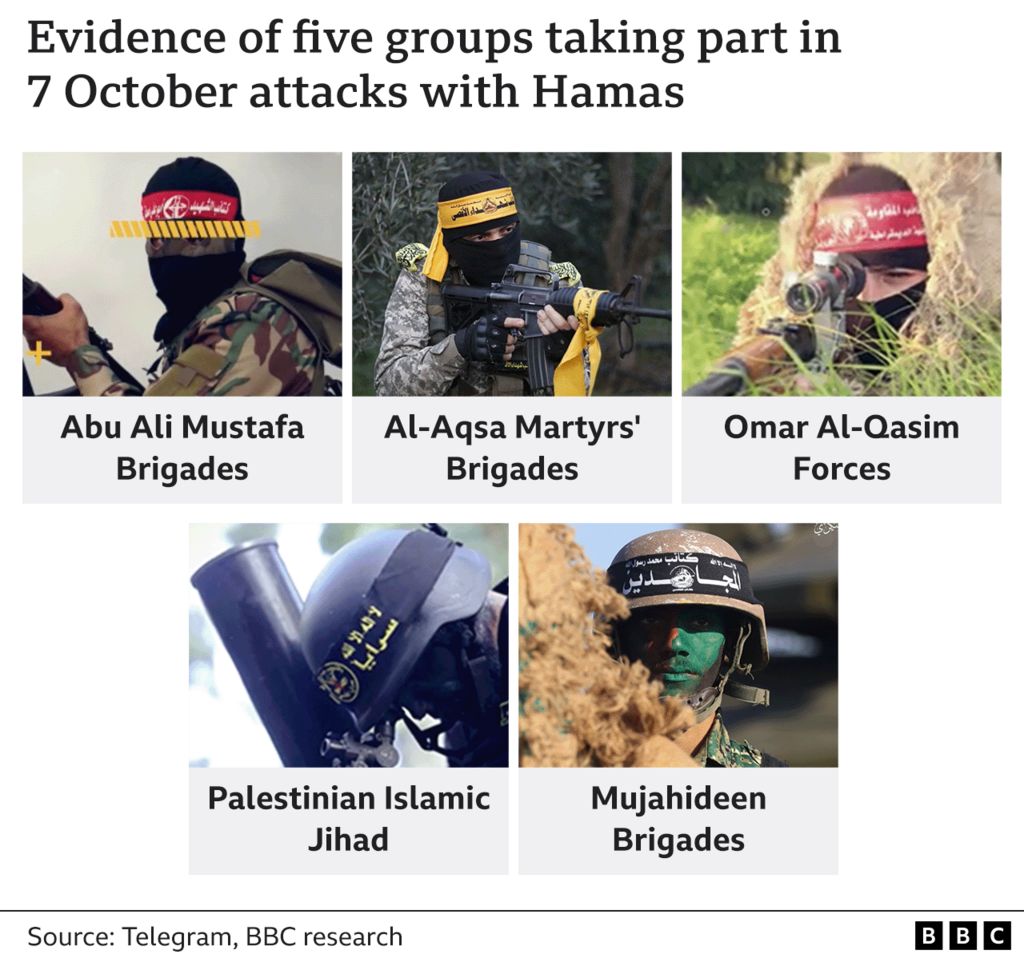
While these groups are drawn from a broad ideological spectrum ranging from hard-line Islamist to relatively secular, all shared a willingness to use violence against Israel.
Hamas statements repeatedly stressed the theme of unity between Gaza’s disparate armed groups. The group suggested they were equal partners in the joint drills, whilst it continued to play a leading role in the plans to attack Israel. Footage from the first drill shows masked commanders in a bunker appearing to conduct the exercise, and begins with a volley of rocket fire.
It cuts to heavily armed fighters overrunning a mocked-up tank marked with an Israeli flag, detaining a crew member and dragging him away as a prisoner, as well as raiding buildings.
We know from videos and harrowing witness statements that both tactics were used to capture soldiers and target civilians on 7 October, when around 1,200 people were killed and an estimated 240 hostages were taken.
Telling the world
The second Strong Pillar drill was held almost exactly one year later.
Ayman Nofal, a commander in the Izzedine al-Qassam Brigades – the official name for Hamas’s armed wing – said the aim of the exercise on 26 December 2021 was to “affirm the unity of the resistance factions”.
He said the drills would “tell the enemy that the walls and engineering measures on the borders of Gaza will not protect them”.
Another Hamas statement said the “joint military manoeuvres” were designed to “simulate the liberation of settlements near Gaza” – which is how the group refers to Israeli communities.
The exercise was repeated on 28 December 2022, and propaganda images of fighters practising clearing buildings and overrunning tanks in what appears to be a replica of a military base were published to mark the event.
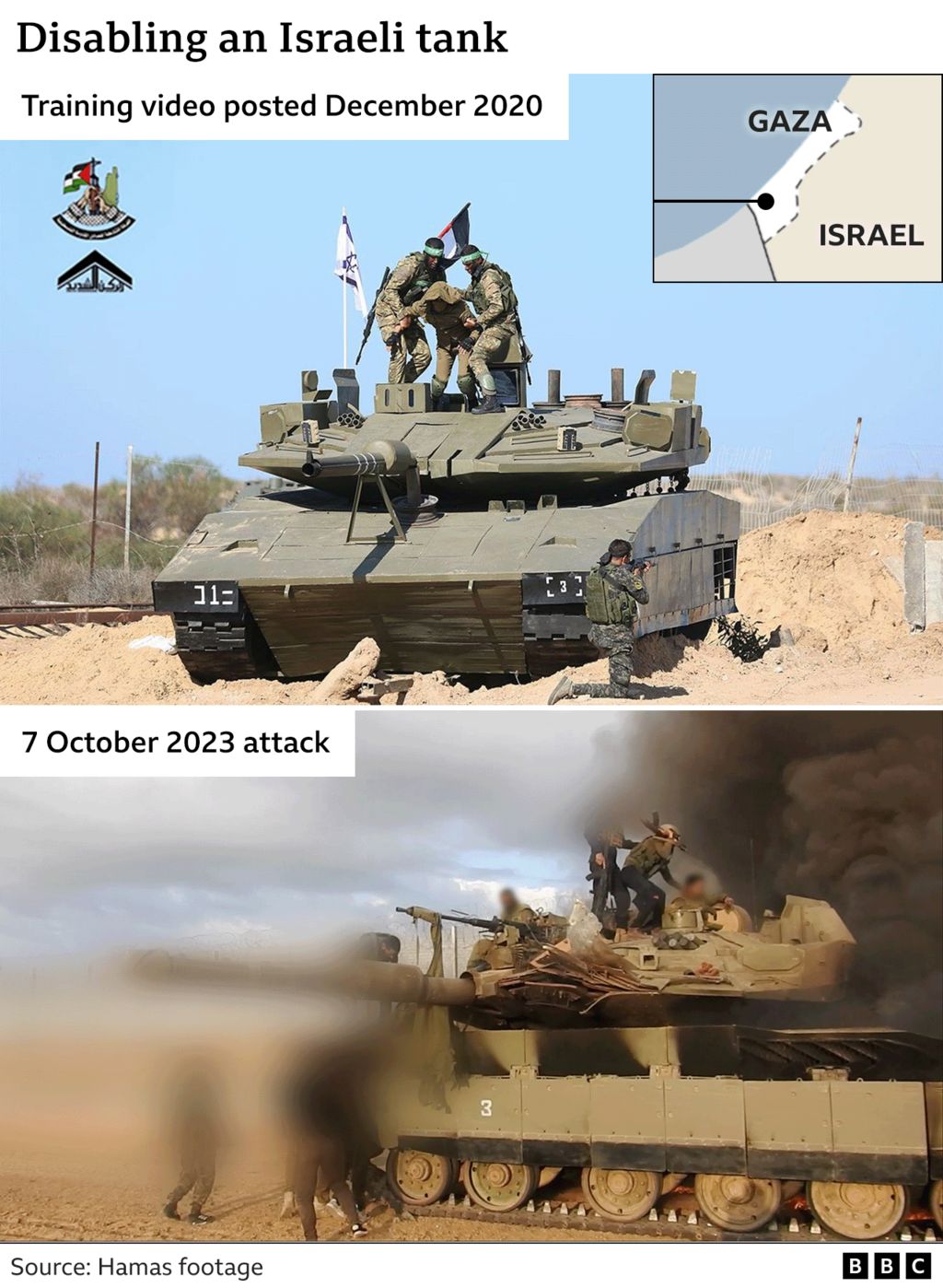
The exercises were reported on in Israel, so it’s inconceivable they were not being closely monitored by the country’s extensive intelligence agencies.
The Israel Defense Forces (IDF) have previously carried out air strikes to disrupt Hamas’s training activities. In April 2023, they bombed the site used for the first Strong Pillar drill.
Weeks before the attacks, female surveillance soldiers near the Gaza border reportedly warned of unusually high drone activity and that Hamas was training to take over observation posts with replicas of their positions.
But, according to reports in the Israeli media, they say they were ignored. Brigadier General Amir Avivi, a former IDF deputy commander in Gaza, told the BBC: “There was a lot of intelligence that they were doing this training – after all, the videos are public, and this was happening just hundreds of metres from the fence (with Israel).”
But he said while the military knew about the drills, they “didn’t see what they were training for”.
The IDF said they “eliminated” Nofal on 17 October 2023, the first senior Hamas military leader to be killed during the conflict.
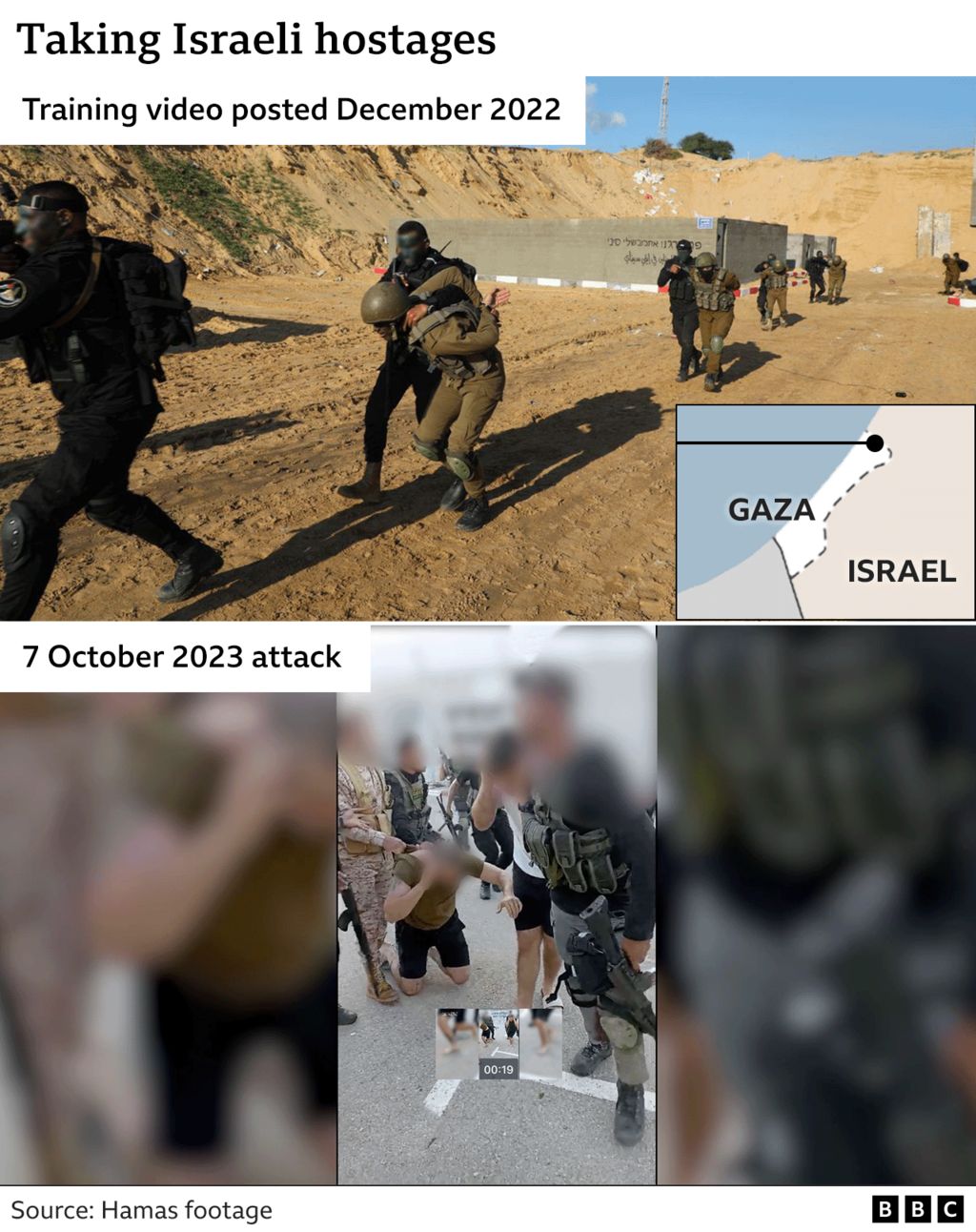
Hiding in plain sight
Hamas went to great lengths to make sure the drills were realistic.
In 2022, fighters practised storming a mock Israeli military base built just 2.6km (1.6 miles) from the Erez crossing, a route between Gaza and Israel controlled by the IDF.
BBC Verify has pinpointed the site in the far north of Gaza, just 800m (0.5 miles) from the barrier, by matching geographic features seen in the training footage to aerial images of the area. As of November 2023, the site was still visible on Bing Maps.
The training camp was within 1.6km (1 mile) of an Israeli observation tower and an elevated observation box, elements in a security barrier Israel has spent hundreds of millions of dollars constructing.
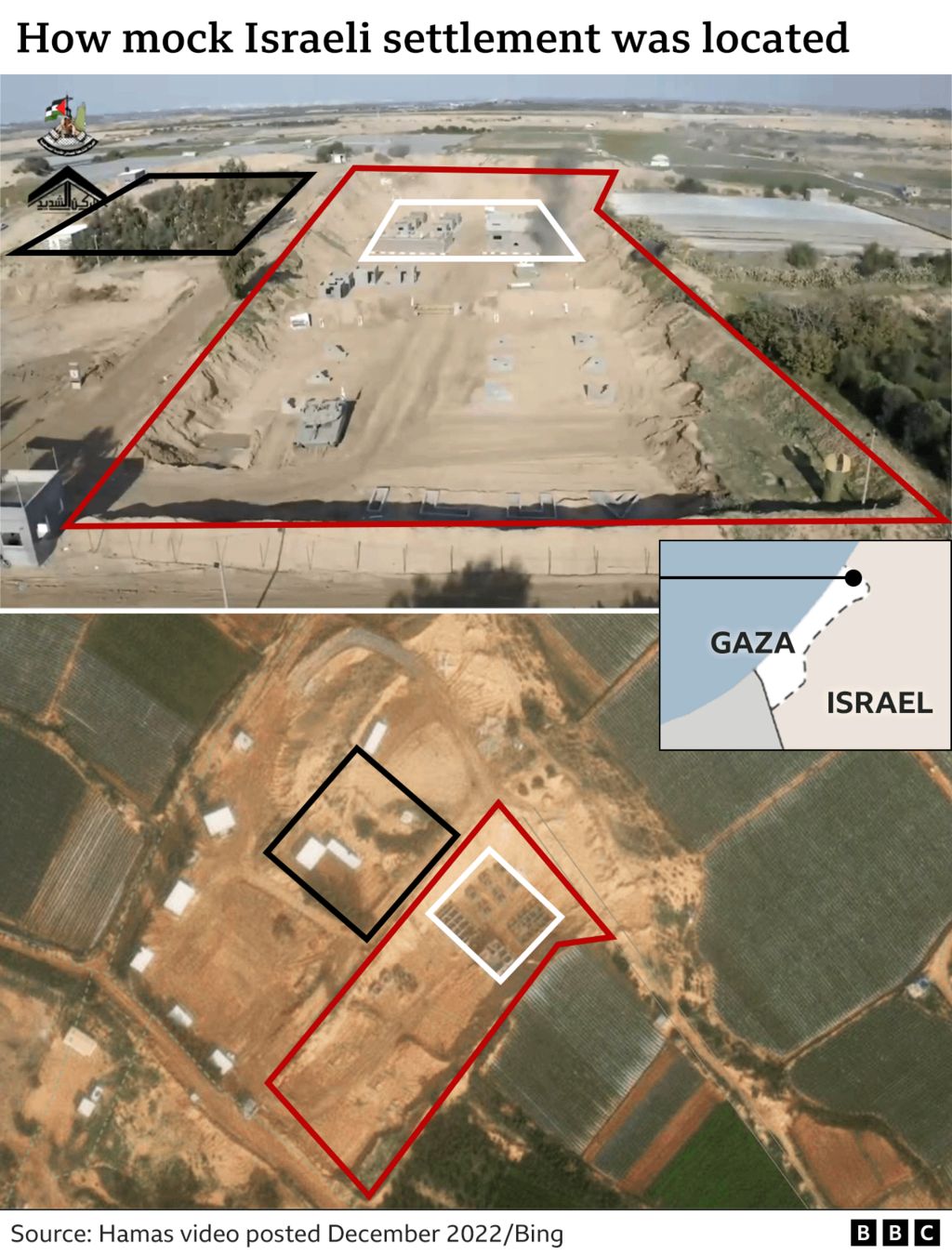
The mock base is on land dug several metres below ground level, so it may not have been immediately visible to any nearby Israeli patrols – but the smoke rising from the explosions surely would have been, and the IDF is known to use aerial surveillance.
Hamas used this site to practise storming buildings, taking hostages at gunpoint and destroying security barriers.
BBC Verify has used publicly available information – including satellite imagery – to locate 14 training sites at nine different locations across Gaza.
They even trained twice at a site less than 1.6 km (1 mile) from the United Nations’ aid agency distribution centre, and which was visible in the background of an official video published by the agency in December 2022.
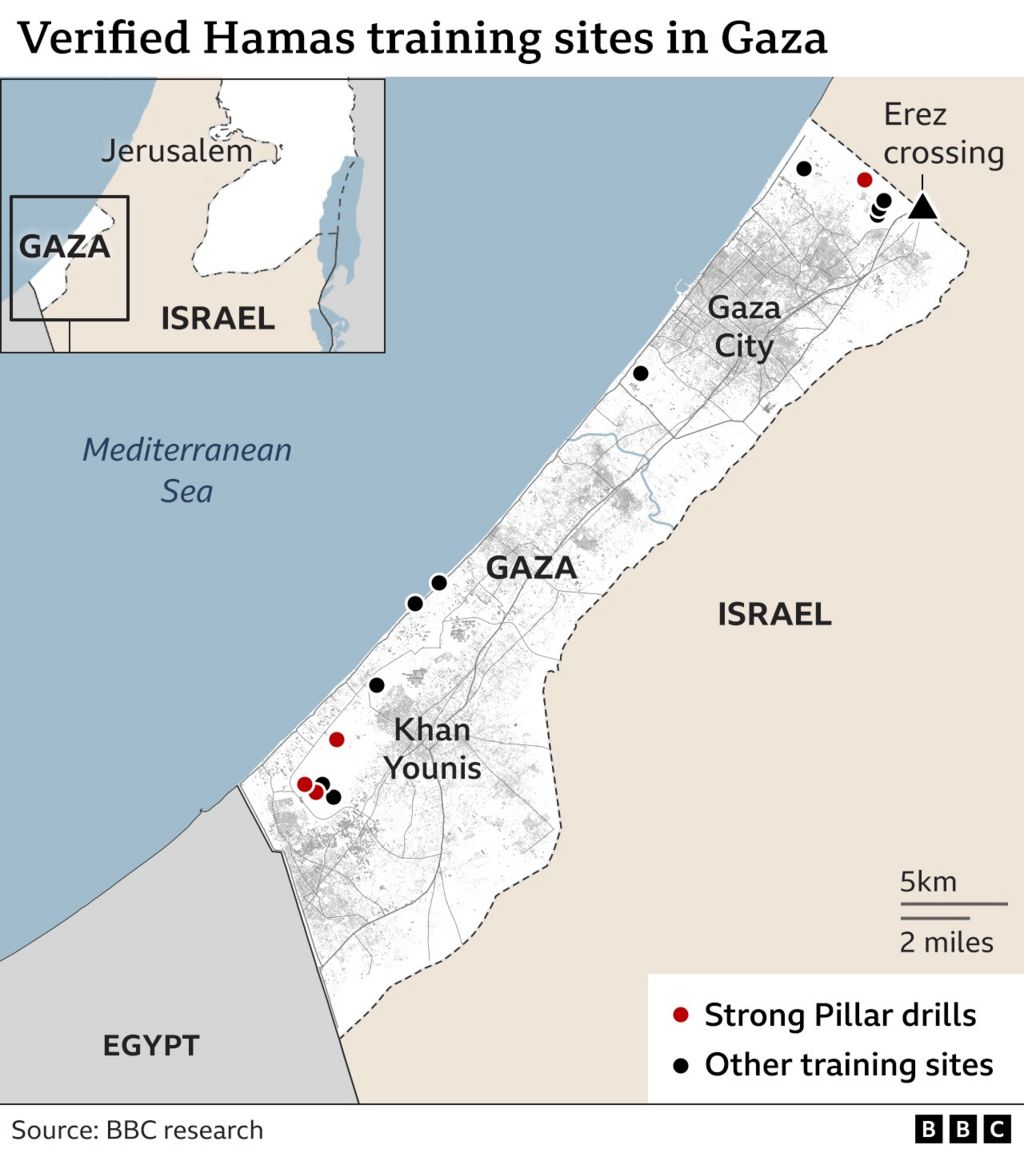
Land, sea and air
On 10 September 2023, the so-called joint committee room published images on its dedicated Telegram channel of men in military uniforms carrying out surveillance of military installations along the Gaza barrier.
Two days later, the fourth Strong Pillar military exercise was staged, and by 7 October, all the tactics that would be deployed in the unprecedented attack had been rehearsed.
Fighters were filmed riding in the same type of white Toyota pickup trucks which were seen roaming through southern Israel the following month.
The propaganda video shows gunmen raiding mock buildings and firing at dummy targets inside, as well as training to storm a beach using a boat and underwater divers. Israel has said it repelled attempted Hamas boat landings on its shores on 7 October.
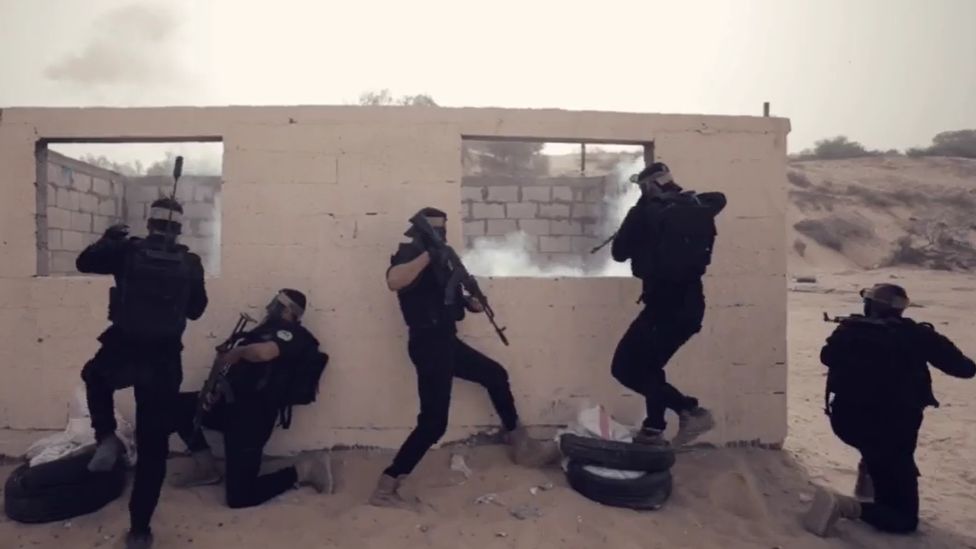
However, Hamas did not publicise its training with motorcycles and paragliders as part of the Strong Pillar propaganda.
A training video posted by Hamas three days after 7 October shows fences and barriers being demolished to allow motorcycles to pass through, a tactic they used to reach communities in southern Israel. We have not identified similar earlier videos.
Footage of fighters using paragliding equipment was also not published until the 7 October attack was under way.
In a training video shared on the day of the attack, gunmen are seen landing in a mock kibbutz at an airstrip we have located to a site north of Rafah in southern Gaza.
BBC Verify established it was recorded some time before 25 August 2022, and was stored in a computer file titled Eagle Squadron, the name Hamas uses for its aerial division – suggesting the paragliders plan was in the works for over a year.
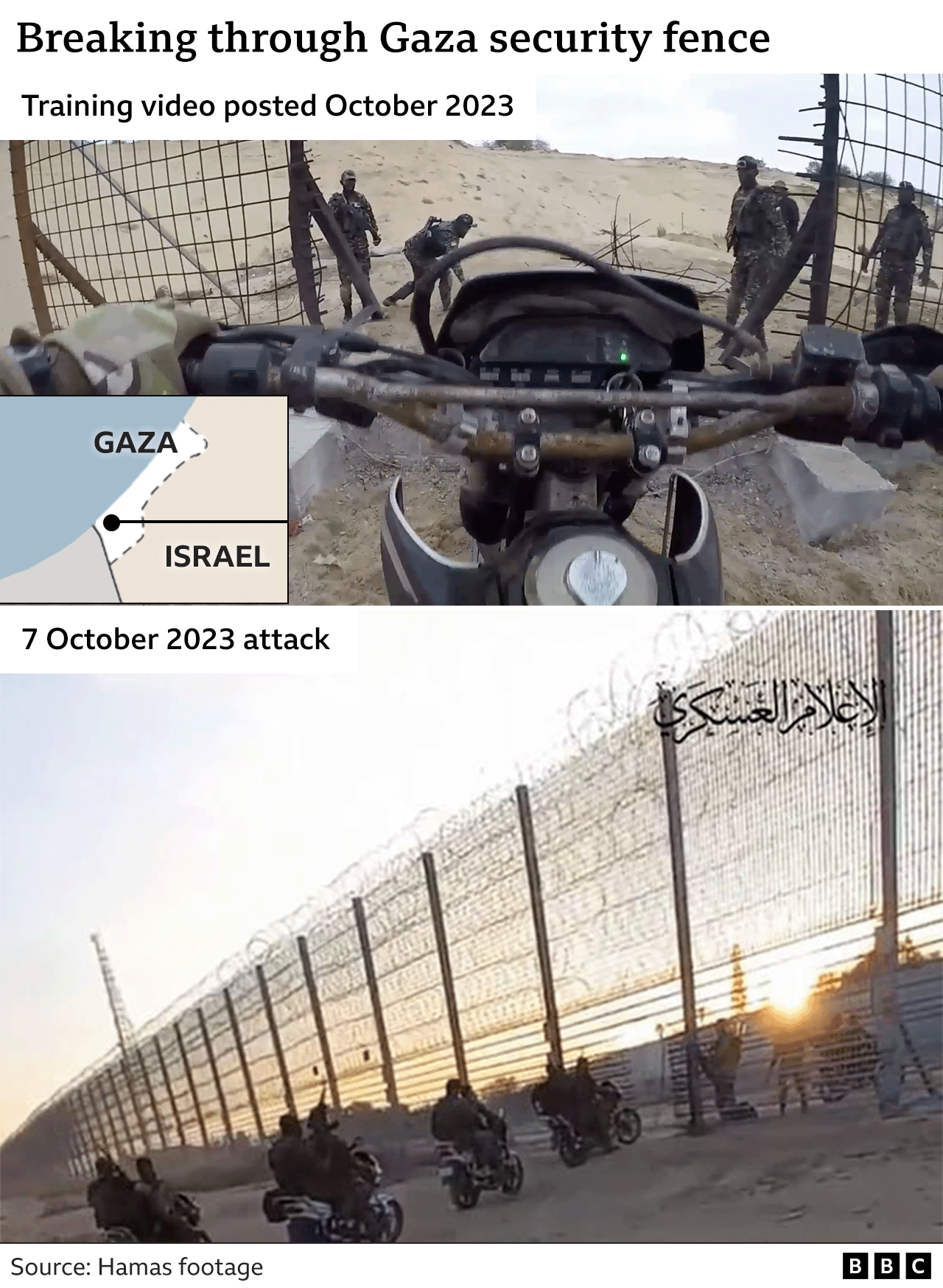
The element of surprise
Before 7 October, Hamas was thought to have about 30,000 fighters in the Gaza Strip, according to reports quoting IDF commanders. It was also thought that Hamas could draw on several thousands of fighters from smaller groups.
Hamas is by far the most powerful of the Palestinian armed groups, even without the support of other factions – suggesting its interest in galvanising the factions was driven by an attempt to secure broad support within Gaza at least as much as bolstering its own numbers.
The IDF has previously estimated 1,500 fighters joined the 7 October raids. The Times of Israel reported earlier this month the IDF now believes the number was closer to 3,000.
Whatever the true number, it means only a relatively small fraction of the total number of armed operatives in Gaza took part. It is not possible to verify precise numbers for how many fighters from smaller groups took part in the attack or the Strong Pillar drills.
While Hamas was building cross-faction support in the build-up to the attack, Hisham Jaber, a former Brigadier General in the Lebanese army who is now a security analyst at the Middle East Centre for Studies and Research, said he believed only Hamas was aware of the ultimate plan, and it was “probable they]asked other factions to join on the day”.
Andreas Krieg, a senior lecturer in security studies at Kings College London, told the BBC: “While there was centralised planning, execution was de-centralised, with each squad operationalising the plan as they saw fit.”
He said he had spoken to people inside Hamas who were surprised by the weakness of Israel’s defences, and assessed militants likely bypassed Israel’s surveillance technology by communicating offline.
Hugh Lovatt, a Middle East analyst at the European Council on Foreign Relations, said Israel would have been aware of the joint training drills but “reached the wrong conclusion”, assessing they amounted to the “standard” activity of paramilitary groups in the Palestinian territories, rather than being “indicative of a looming large-scale attack”.
Asked about the issues raised in this article, the Israel Defense Forces said it was “currently focused on eliminating the threat from the terrorist organisation Hamas” and questions about any potential failures “will be looked into in a later stage”.
It could be several years until Israel formally reckons with whether it missed opportunities to prevent the 7 October massacre. The ramifications for its military, intelligence services and government could be seismic.
(BBC)
Features
The heart-friendly health minister

by Dr Gotabhya Ranasinghe
Senior Consultant Cardiologist
National Hospital Sri Lanka
When we sought a meeting with Hon Dr. Ramesh Pathirana, Minister of Health, he graciously cleared his busy schedule to accommodate us. Renowned for his attentive listening and deep understanding, Minister Pathirana is dedicated to advancing the health sector. His openness and transparency exemplify the qualities of an exemplary politician and minister.
Dr. Palitha Mahipala, the current Health Secretary, demonstrates both commendable enthusiasm and unwavering support. This combination of attributes makes him a highly compatible colleague for the esteemed Minister of Health.
Our discussion centered on a project that has been in the works for the past 30 years, one that no other minister had managed to advance.
Minister Pathirana, however, recognized the project’s significance and its potential to revolutionize care for heart patients.
The project involves the construction of a state-of-the-art facility at the premises of the National Hospital Colombo. The project’s location within the premises of the National Hospital underscores its importance and relevance to the healthcare infrastructure of the nation.
This facility will include a cardiology building and a tertiary care center, equipped with the latest technology to handle and treat all types of heart-related conditions and surgeries.
Securing funding was a major milestone for this initiative. Minister Pathirana successfully obtained approval for a $40 billion loan from the Asian Development Bank. With the funding in place, the foundation stone is scheduled to be laid in September this year, and construction will begin in January 2025.
This project guarantees a consistent and uninterrupted supply of stents and related medications for heart patients. As a result, patients will have timely access to essential medical supplies during their treatment and recovery. By securing these critical resources, the project aims to enhance patient outcomes, minimize treatment delays, and maintain the highest standards of cardiac care.
Upon its fruition, this monumental building will serve as a beacon of hope and healing, symbolizing the unwavering dedication to improving patient outcomes and fostering a healthier society.We anticipate a future marked by significant progress and positive outcomes in Sri Lanka’s cardiovascular treatment landscape within the foreseeable timeframe.
Features
A LOVING TRIBUTE TO JESUIT FR. ALOYSIUS PIERIS ON HIS 90th BIRTHDAY

by Fr. Emmanuel Fernando, OMI
Jesuit Fr. Aloysius Pieris (affectionately called Fr. Aloy) celebrated his 90th birthday on April 9, 2024 and I, as the editor of our Oblate Journal, THE MISSIONARY OBLATE had gone to press by that time. Immediately I decided to publish an article, appreciating the untiring selfless services he continues to offer for inter-Faith dialogue, the renewal of the Catholic Church, his concern for the poor and the suffering Sri Lankan masses and to me, the present writer.
It was in 1988, when I was appointed Director of the Oblate Scholastics at Ampitiya by the then Oblate Provincial Fr. Anselm Silva, that I came to know Fr. Aloy more closely. Knowing well his expertise in matters spiritual, theological, Indological and pastoral, and with the collaborative spirit of my companion-formators, our Oblate Scholastics were sent to Tulana, the Research and Encounter Centre, Kelaniya, of which he is the Founder-Director, for ‘exposure-programmes’ on matters spiritual, biblical, theological and pastoral. Some of these dimensions according to my view and that of my companion-formators, were not available at the National Seminary, Ampitiya.
Ever since that time, our Oblate formators/ accompaniers at the Oblate Scholasticate, Ampitiya , have continued to send our Oblate Scholastics to Tulana Centre for deepening their insights and convictions regarding matters needed to serve the people in today’s context. Fr. Aloy also had tried very enthusiastically with the Oblate team headed by Frs. Oswald Firth and Clement Waidyasekara to begin a Theologate, directed by the Religious Congregations in Sri Lanka, for the contextual formation/ accompaniment of their members. It should very well be a desired goal of the Leaders / Provincials of the Religious Congregations.
Besides being a formator/accompanier at the Oblate Scholasticate, I was entrusted also with the task of editing and publishing our Oblate journal, ‘The Missionary Oblate’. To maintain the quality of the journal I continue to depend on Fr. Aloy for his thought-provoking and stimulating articles on Biblical Spirituality, Biblical Theology and Ecclesiology. I am very grateful to him for his generous assistance. Of late, his writings on renewal of the Church, initiated by Pope St. John XX111 and continued by Pope Francis through the Synodal path, published in our Oblate journal, enable our readers to focus their attention also on the needed renewal in the Catholic Church in Sri Lanka. Fr. Aloy appreciated very much the Synodal path adopted by the Jesuit Pope Francis for the renewal of the Church, rooted very much on prayerful discernment. In my Religious and presbyteral life, Fr.Aloy continues to be my spiritual animator / guide and ongoing formator / acccompanier.
Fr. Aloysius Pieris, BA Hons (Lond), LPh (SHC, India), STL (PFT, Naples), PhD (SLU/VC), ThD (Tilburg), D.Ltt (KU), has been one of the eminent Asian theologians well recognized internationally and one who has lectured and held visiting chairs in many universities both in the West and in the East. Many members of Religious Congregations from Asian countries have benefited from his lectures and guidance in the East Asian Pastoral Institute (EAPI) in Manila, Philippines. He had been a Theologian consulted by the Federation of Asian Bishops’ Conferences for many years. During his professorship at the Gregorian University in Rome, he was called to be a member of a special group of advisers on other religions consulted by Pope Paul VI.
Fr. Aloy is the author of more than 30 books and well over 500 Research Papers. Some of his books and articles have been translated and published in several countries. Among those books, one can find the following: 1) The Genesis of an Asian Theology of Liberation (An Autobiographical Excursus on the Art of Theologising in Asia, 2) An Asian Theology of Liberation, 3) Providential Timeliness of Vatican 11 (a long-overdue halt to a scandalous millennium, 4) Give Vatican 11 a chance, 5) Leadership in the Church, 6) Relishing our faith in working for justice (Themes for study and discussion), 7) A Message meant mainly, not exclusively for Jesuits (Background information necessary for helping Francis renew the Church), 8) Lent in Lanka (Reflections and Resolutions, 9) Love meets wisdom (A Christian Experience of Buddhism, 10) Fire and Water 11) God’s Reign for God’s poor, 12) Our Unhiddden Agenda (How we Jesuits work, pray and form our men). He is also the Editor of two journals, Vagdevi, Journal of Religious Reflection and Dialogue, New Series.
Fr. Aloy has a BA in Pali and Sanskrit from the University of London and a Ph.D in Buddhist Philosophy from the University of Sri Lankan, Vidyodaya Campus. On Nov. 23, 2019, he was awarded the prestigious honorary Doctorate of Literature (D.Litt) by the Chancellor of the University of Kelaniya, the Most Venerable Welamitiyawe Dharmakirthi Sri Kusala Dhamma Thera.
Fr. Aloy continues to be a promoter of Gospel values and virtues. Justice as a constitutive dimension of love and social concern for the downtrodden masses are very much noted in his life and work. He had very much appreciated the commitment of the late Fr. Joseph (Joe) Fernando, the National Director of the Social and Economic Centre (SEDEC) for the poor.
In Sri Lanka, a few religious Congregations – the Good Shepherd Sisters, the Christian Brothers, the Marist Brothers and the Oblates – have invited him to animate their members especially during their Provincial Congresses, Chapters and International Conferences. The mainline Christian Churches also have sought his advice and followed his seminars. I, for one, regret very much, that the Sri Lankan authorities of the Catholic Church –today’s Hierarchy—- have not sought Fr.
Aloy’s expertise for the renewal of the Catholic Church in Sri Lanka and thus have not benefited from the immense store of wisdom and insight that he can offer to our local Church while the Sri Lankan bishops who governed the Catholic church in the immediate aftermath of the Second Vatican Council (Edmund Fernando OMI, Anthony de Saram, Leo Nanayakkara OSB, Frank Marcus Fernando, Paul Perera,) visited him and consulted him on many matters. Among the Tamil Bishops, Bishop Rayappu Joseph was keeping close contact with him and Bishop J. Deogupillai hosted him and his team visiting him after the horrible Black July massacre of Tamils.
Features
A fairy tale, success or debacle

Sri Lanka-Singapore Free Trade Agreement
By Gomi Senadhira
senadhiragomi@gmail.com
“You might tell fairy tales, but the progress of a country cannot be achieved through such narratives. A country cannot be developed by making false promises. The country moved backward because of the electoral promises made by political parties throughout time. We have witnessed that the ultimate result of this is the country becoming bankrupt. Unfortunately, many segments of the population have not come to realize this yet.” – President Ranil Wickremesinghe, 2024 Budget speech
Any Sri Lankan would agree with the above words of President Wickremesinghe on the false promises our politicians and officials make and the fairy tales they narrate which bankrupted this country. So, to understand this, let’s look at one such fairy tale with lots of false promises; Ranil Wickremesinghe’s greatest achievement in the area of international trade and investment promotion during the Yahapalana period, Sri Lanka-Singapore Free Trade Agreement (SLSFTA).
It is appropriate and timely to do it now as Finance Minister Wickremesinghe has just presented to parliament a bill on the National Policy on Economic Transformation which includes the establishment of an Office for International Trade and the Sri Lanka Institute of Economics and International Trade.
Was SLSFTA a “Cleverly negotiated Free Trade Agreement” as stated by the (former) Minister of Development Strategies and International Trade Malik Samarawickrama during the Parliamentary Debate on the SLSFTA in July 2018, or a colossal blunder covered up with lies, false promises, and fairy tales? After SLSFTA was signed there were a number of fairy tales published on this agreement by the Ministry of Development Strategies and International, Institute of Policy Studies, and others.
However, for this article, I would like to limit my comments to the speech by Minister Samarawickrama during the Parliamentary Debate, and the two most important areas in the agreement which were covered up with lies, fairy tales, and false promises, namely: revenue loss for Sri Lanka and Investment from Singapore. On the other important area, “Waste products dumping” I do not want to comment here as I have written extensively on the issue.
1. The revenue loss
During the Parliamentary Debate in July 2018, Minister Samarawickrama stated “…. let me reiterate that this FTA with Singapore has been very cleverly negotiated by us…. The liberalisation programme under this FTA has been carefully designed to have the least impact on domestic industry and revenue collection. We have included all revenue sensitive items in the negative list of items which will not be subject to removal of tariff. Therefore, 97.8% revenue from Customs duty is protected. Our tariff liberalisation will take place over a period of 12-15 years! In fact, the revenue earned through tariffs on goods imported from Singapore last year was Rs. 35 billion.
The revenue loss for over the next 15 years due to the FTA is only Rs. 733 million– which when annualised, on average, is just Rs. 51 million. That is just 0.14% per year! So anyone who claims the Singapore FTA causes revenue loss to the Government cannot do basic arithmetic! Mr. Speaker, in conclusion, I call on my fellow members of this House – don’t mislead the public with baseless criticism that is not grounded in facts. Don’t look at petty politics and use these issues for your own political survival.”
I was surprised to read the minister’s speech because an article published in January 2018 in “The Straits Times“, based on information released by the Singaporean Negotiators stated, “…. With the FTA, tariff savings for Singapore exports are estimated to hit $10 million annually“.
As the annual tariff savings (that is the revenue loss for Sri Lanka) calculated by the Singaporean Negotiators, Singaporean $ 10 million (Sri Lankan rupees 1,200 million in 2018) was way above the rupees’ 733 million revenue loss for 15 years estimated by the Sri Lankan negotiators, it was clear to any observer that one of the parties to the agreement had not done the basic arithmetic!
Six years later, according to a report published by “The Morning” newspaper, speaking at the Committee on Public Finance (COPF) on 7th May 2024, Mr Samarawickrama’s chief trade negotiator K.J. Weerasinghehad had admitted “…. that forecasted revenue loss for the Government of Sri Lanka through the Singapore FTA is Rs. 450 million in 2023 and Rs. 1.3 billion in 2024.”
If these numbers are correct, as tariff liberalisation under the SLSFTA has just started, we will pass Rs 2 billion very soon. Then, the question is how Sri Lanka’s trade negotiators made such a colossal blunder. Didn’t they do their basic arithmetic? If they didn’t know how to do basic arithmetic they should have at least done their basic readings. For example, the headline of the article published in The Straits Times in January 2018 was “Singapore, Sri Lanka sign FTA, annual savings of $10m expected”.
Anyway, as Sri Lanka’s chief negotiator reiterated at the COPF meeting that “…. since 99% of the tariffs in Singapore have zero rates of duty, Sri Lanka has agreed on 80% tariff liberalisation over a period of 15 years while expecting Singapore investments to address the imbalance in trade,” let’s turn towards investment.
Investment from Singapore
In July 2018, speaking during the Parliamentary Debate on the FTA this is what Minister Malik Samarawickrama stated on investment from Singapore, “Already, thanks to this FTA, in just the past two-and-a-half months since the agreement came into effect we have received a proposal from Singapore for investment amounting to $ 14.8 billion in an oil refinery for export of petroleum products. In addition, we have proposals for a steel manufacturing plant for exports ($ 1 billion investment), flour milling plant ($ 50 million), sugar refinery ($ 200 million). This adds up to more than $ 16.05 billion in the pipeline on these projects alone.
And all of these projects will create thousands of more jobs for our people. In principle approval has already been granted by the BOI and the investors are awaiting the release of land the environmental approvals to commence the project.
I request the Opposition and those with vested interests to change their narrow-minded thinking and join us to develop our country. We must always look at what is best for the whole community, not just the few who may oppose. We owe it to our people to courageously take decisions that will change their lives for the better.”
According to the media report I quoted earlier, speaking at the Committee on Public Finance (COPF) Chief Negotiator Weerasinghe has admitted that Sri Lanka was not happy with overall Singapore investments that have come in the past few years in return for the trade liberalisation under the Singapore-Sri Lanka Free Trade Agreement. He has added that between 2021 and 2023 the total investment from Singapore had been around $162 million!
What happened to those projects worth $16 billion negotiated, thanks to the SLSFTA, in just the two-and-a-half months after the agreement came into effect and approved by the BOI? I do not know about the steel manufacturing plant for exports ($ 1 billion investment), flour milling plant ($ 50 million) and sugar refinery ($ 200 million).
However, story of the multibillion-dollar investment in the Petroleum Refinery unfolded in a manner that would qualify it as the best fairy tale with false promises presented by our politicians and the officials, prior to 2019 elections.
Though many Sri Lankans got to know, through the media which repeatedly highlighted a plethora of issues surrounding the project and the questionable credentials of the Singaporean investor, the construction work on the Mirrijiwela Oil Refinery along with the cement factory began on the24th of March 2019 with a bang and Minister Ranil Wickremesinghe and his ministers along with the foreign and local dignitaries laid the foundation stones.
That was few months before the 2019 Presidential elections. Inaugurating the construction work Prime Minister Ranil Wickremesinghe said the projects will create thousands of job opportunities in the area and surrounding districts.
The oil refinery, which was to be built over 200 acres of land, with the capacity to refine 200,000 barrels of crude oil per day, was to generate US$7 billion of exports and create 1,500 direct and 3,000 indirect jobs. The construction of the refinery was to be completed in 44 months. Four years later, in August 2023 the Cabinet of Ministers approved the proposal presented by President Ranil Wickremesinghe to cancel the agreement with the investors of the refinery as the project has not been implemented! Can they explain to the country how much money was wasted to produce that fairy tale?
It is obvious that the President, ministers, and officials had made huge blunders and had deliberately misled the public and the parliament on the revenue loss and potential investment from SLSFTA with fairy tales and false promises.
As the president himself said, a country cannot be developed by making false promises or with fairy tales and these false promises and fairy tales had bankrupted the country. “Unfortunately, many segments of the population have not come to realize this yet”.
(The writer, a specialist and an activist on trade and development issues . )


